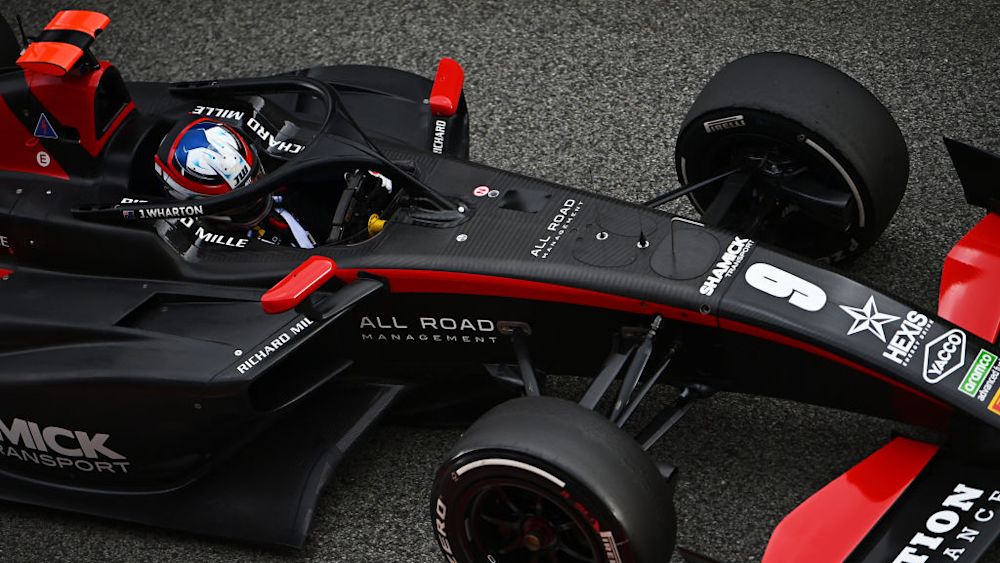Feature
F3 Explained: How the new car is closer to F2 than ever before

With two races in the books in 2025, the new era of FIA Formula 3 is taking shape, and the teams and drivers are learning with every lap.
The changes and introduction of several new aspects, from aerodynamics to larger 16-inch tyres are all obvious, but the changes go beyond appearances.
In the second part of our ‘F3 Explained’ series this year, we take a look at how the cockpit and steering wheel of the new car have been designed with the next steps in a driver’s career in mind.
F2 and F3 Technical Director Pierre-Alain Michot starts with the steering wheel, and how it now mirrors those found in a Formula 2 cockpit.
“Aesthetically, the handles have been made smaller to accommodate drivers of all sizes,” Michot explains. “That’s the main difference looks-wise between the older wheel and the new one. It’s the same hardware overall, but the big differences come with the electronics.
“You have a new Marelli VCU (Vehicle Control Unit), new power box and a lot of new things that the driver controls within the car, but there’s no major changes to the design.
“You could now take a steering wheel from an F3 car and put it on an F2 car, and it would be the exact same. The change with the new car has been made so that the F3 cockpit, from the pedals to the steering wheel, are the same in dimensions as an F2 car.”

The ergonomics of the steering wheel have modified to match those found in F2 while the electronics have been changed to allow drivers to have control of different parameters from the touch of a button or flick of a switch.
Just as drivers would in F1 or F2, F3 drivers can adjust their car from the steering wheel, while the displays on the physical wheel mirrors that found in an F2 car, achieved through the new VCU.
“It helps the drivers who step up to F2 from F3... Now, they could take their seat from one car and put it in the other"
“It’s mainly the electronics that have changed because of the needs of the new car,” Michot continues. “We have a lot more capabilities with the new VCU, and we’re able to accommodate many more features into the steering wheel, like the marshalling system, engine management, and other bits.
“The DRS system is a hydraulic system along with the clutch management and shifting systems for the car, so they’re not directly connected to the new electronics. It’s the same system as in the F2 car, so it’s managed by the Vehicle Control Unit by Marelli but isn’t electronic.
“The main switches on the steering wheel are used to change the engine and clutch maps. When drivers arrive on the grid, they have adjusted the clutch map or the engine map if they want to change the throttle behaviour.

“We have the start map which must be selected for the start, but once the start procedure is complete, teams and drivers can go to a different map as desired.”
As the drivers control their car using the wheel and systems available at their fingertips, where they’re situated whilst doing it is just as important and an area of focus with the new F3 car.
Just as is the case with the steering wheel, the form of the cockpit follows the lead of F2, meaning when the time comes for a step up, drivers are already familiar with their position in the car.
READ MORE: F3 Explained: The cutting-edge technology powering the all-new 2025 car
A byproduct is that teams don’t need to spend as much time as in the past to accommodate drivers, whilst the Championship doesn’t have to produce different specification parts in the first place, with the homogenous design used across both F2 and F3.
“It helps the drivers who step up to F2 from F3, as they will find they have a familiar environment in the car. Now, they could take their seat from one car and put it in the other.
“It also helps on our side as well, with the use of common parts and losing the requirement to design and manufacture two different models to accommodate the two cockpits. Now with it being the same for both, it makes teams’ lives easier as well.

“If a driver in F3 wants to move up to F2 and do it quickly in the same team, they could just use the adjustable parts they have in the F3 cockpit in the F2 one instead of buying something completely new.”
All of the above combines to tutor the drivers about how to manage their car from the cockpit beyond the racing lines they take and how aggressive they are with their steering inputs.
It all feeds into the concept of the FIA single-seater pyramid and preparing drivers for future steps in their careers, whilst keeping the FIA F3 Championship relevant and closer to the racing championships that come next.
All the changes should help the drivers in their adjustment to not only the increased workload from the cockpit, but also their development as racing drivers.
“The steering wheel is designed to make sure the drivers are already trained for whatever they have to do in F2 and eventually, F1,” Michot begins. “If you look at how many switches and rotaries they use in an F1 race, it’s a good step to have an introduction to this.”